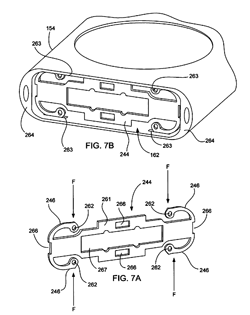Patent application revelations II


Some of the more interesting parts of Apple's patent application discuss a seamless one-piece iPod enclosure constructed from radio transparent ceramics and internal rails that serve as a guide for positioning and supporting the internal components.
Today I'll discuss some of the other interesting aspects of United States Patent Application #20060268528 as they are likely to be a prelude of things to come from Apple.
Multiple input devices
I've previously mentioned that the new patent indicates that the new iPod device will be more modular than ever allowing internal components to be inserted through open ends of the enclosure. But the patent goes deeper, hinting that modules may be interchangeable to accommodate different needs and that we may be able to use multiple input devices.
user interface elements may correspond to a display and/or an input device such as a keypad, touch pad, touch screen, joystick, trackball, buttons, switches and/or the like.
Dedicated power
The patent goes on to discuss the potential of a dedicated power button on the iPod which would be a first for the product line.
The computing device 100 also includes one or more switches 112 including power switches, hold switches, and the like. The power switch is configured to turn the device 100 on and off
Many novice users complain about the iPod's lack of a power switch and have difficulty figuring out that pausing the iPod will (eventually) force it to turn off.
Even more interesting is the patent's mention of a dedicated power port:
The device 100 may also include one or more connectors 116 for transferring data and/or power to and from the device 100. In the illustrated embodiment, the device 100 includes an audio jack 116A, a data port 116B and a power port 116C... The power port 116C, on the other hand, allows power to be delivered to the computing device 100
In its five years of existence the iPod has always received power from either the FireWire or USB 2.0 cable. A dedicated power port on an iPod could mean the end of Apple's proprietary 30-pin "dock connector" and backwards compatibility with thousands of accessories that connect to it. In one scenario, Apple could switch to a micro USB connector for data transfer and a dedicated power connector for AC power.
A true USB port on the iPod would be delightful for users that want a standard USB connection for times when they forget to bring their "iPod cable" with them. Customer-oriented companies (like RIM/Blackberry) are already using micro USB power connectors on their devices instead of expensive proprietary connectors that leave their customers stranded with a dead phone.
While accessory manufacturers will have to retool for the new device, it's high time that Apple abandon their expensive dock connector for a more standards-based connector like USB. My sense is that Apple is considering the USB port for the iPhone so that consumers will have the most charging options for the device. A phone is lot more critical than an iPod in life threatening situations and I hope that Apple takes this into account.
As a betting man, I'd say that Apple sticks with the dock connector for dedicated iPods because they like the extra revenue they get from cables and to maintain compatibility with existing iPod accessories.
Battery Technology
The patent mentions a new type of battery not previously used by Apple:
the battery may correspond to a rechargeable lithium polymer battery or a lithium ion prismatic cell. These type of batteries are capable of offering about 10 hours of continuous playtime to the device
According to IEEE prismatic design cells which use a lithium manganese oxide based cathode material should be much less costly and safer than Lithium-ion (Li-ion) or lithium polymer batteries (LiPo). Curiously, the new cells meet many military performance criteria, but "the most significant drawback of this technology, at the present time, is the short cycle life."
The usual patent disclaimers apply: Apple may never use any of the items in this patent or they may incorporate all of the into some sort of frankenphone. They're using the patent to protect as much technology and balancing that with giving as few hints as possible to the media and competitors.